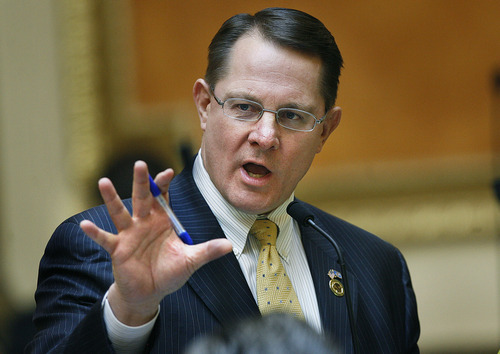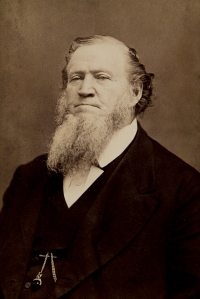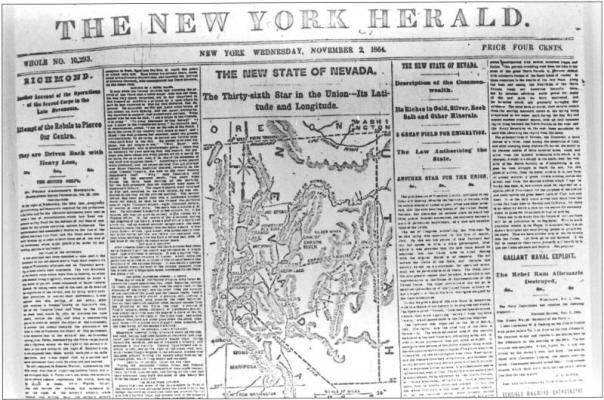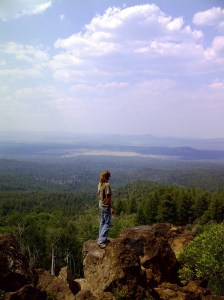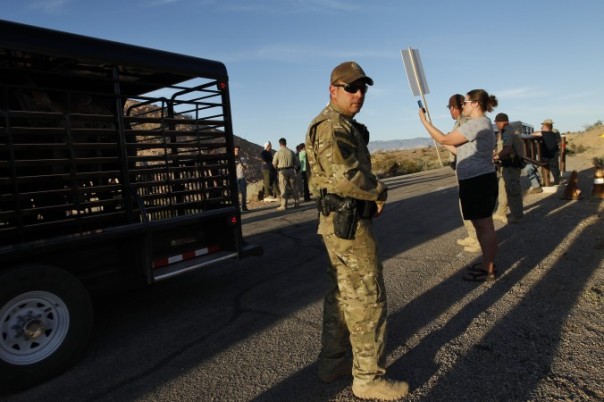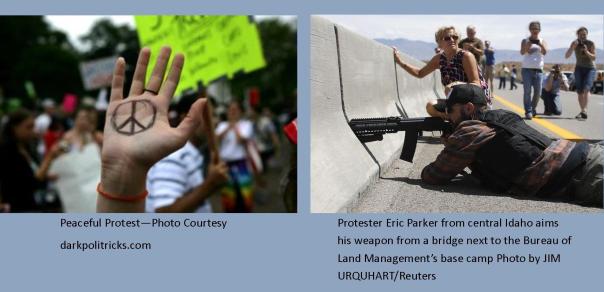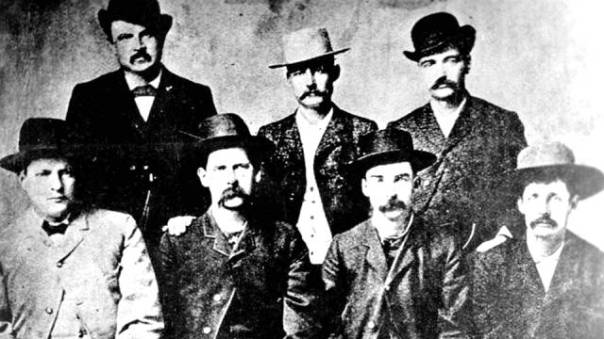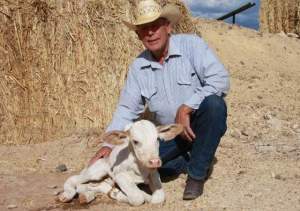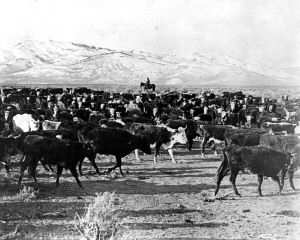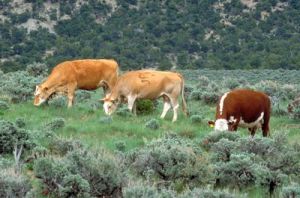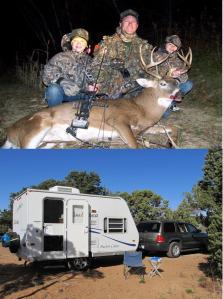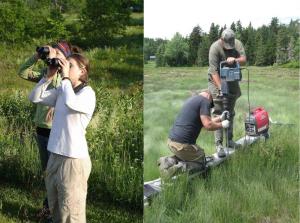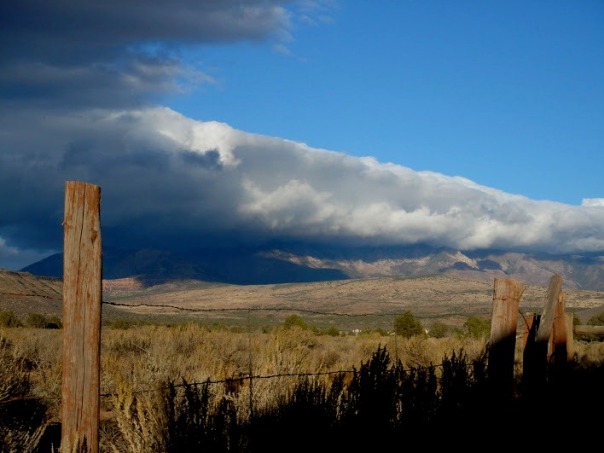Blog Archives
Mob Rule Wins, BLM Averts Bloodshed
Bundy Won, America Lost by Dallas Hyland
Originally published in St. George News
Mark Twain famously said, “Loyalty to country always. Loyalty to government when it deserves it.” Until today I had always been one to lean on the improbability that the government ever really deserves it. But when the government chose to back down to avert the bloodshed of innocent life, while Cliven Bundy shamelessly put innocent life in harms way for his own agenda, I knew to whom loyalty belonged.
As Clark County Sheriff Doug Gillespie announced the stand-down of the Bureau of Land Management’s round up of Bundy’s cattle from federal land, there was reported to be a collective sigh of relief. It was over.
The round up, which began last week, which was adjudicated by federal court order and was being carried out by the BLM as well as adjoining agencies and civilian contractors, drew supporters for Bundy ranging from sympathetic ranchers and citizens to armed militias who mingled throughout out the crowds in the area.
The spirit of de-escalation was however short lived.
Cliven Bundy came forth after Gillespie, and when he spoke, betrayed the terms of the stand-down announcing a series of demands that included but are not limited to the disarming of federal agents, dismantling the BLM and NPS, and the removal of gates to national parks. This is consistent with the statements made last Wednesday by his son Ryan Bundy on the Perspectives Show with Bryan Hyde and Kate Dalley.
Later, Bundy gave the order to the militia to get his cows back, which led to a tense standoff in a wash with dozens of Las Vegas Metro Police. The militia took their stand surrounded by women and children also in protest and demanded that the cattle be released.
Deputy Chief Tom Roberts, of Las Vegas Metro, then made an agreement with Bundy’s son Ammon, to release the cattle held there within 30 minutes if the crowd agreed to disperse.
Advocates for Bundy are hailing this a victory for not only Bundy, but for America as a whole and inferring that this is in fact a demonstration of the power of peaceful rebellion, of civil disobedience, despite that, there was nothing peaceful about it. In actuality, this has perhaps done something quite different.
The stand-down gave a symbolic victory to radical anti-government militia groups, but more importantly, this event has changed the collective definition of the meaning of civil disobedience in America for the worst.
In an article in The Southwest Journal, a compelling case for the distinctions between criminal behavior for selfish gain and civil disobedience for the greater good of people is made.
The main thrust of such distinctions is that a true act of civil disobedience is marked by an emphasis by the disobedient acquiescing to the knowledge that they are breaking the law and accept the penalty for it in the interest of the common good. There is still respect for, and submission to, the law.
Bundy does not think he has done a single thing wrong and furthermore, revealed his true character in the matter when in lieu of not getting his innocuous demands for a version of government take down and overthrow, he simply demanded people take back his cattle. Perhaps his sole motive all along despite alluding to some fashion of patriotism.
But beyond such distinctions, another compelling case can be made for the media’s role in ratcheting up the fanaticism that ultimately was the cause of the breakdown of the agreement made between the BLM and Bundy, as well as the decision to cease the roundup.
Furthermore, Bundy himself is responsible for doing less for the cause of putting into check a presumed-overbearing federal government. Instead, he appealed to the nature of mob rule and incited potential violence – even when peace had been brokered.
In a 1968 article by Delbert D. Smith, the case for the deterioration of meaningful and effective civil disobedience as well as the media and general public’s culpability thereof, some 35 years later, still holds an almost prophetic weight. Smith writes:
“One difficulty that the courts face with cases of civil disobedience is that the techniques are constantly changing because of the necessity of attracting public attention and notice. The ‘news’ content of the event and its adaptability to television or magazine coverage have become important criteria for determining the nature of civilly disobedient acts. It can be argued that the most undesirable forms of civil disobedience have developed as a result of the irresponsibility of our mass media. However, the alternative course of action, which would be to prescribe some form of news management, seems equally undesirable. News suppression would not be viable in any event since the news media are able to ‘color’ an event simply by their use, non-use or placement of a particular article.
While it is possible to assert that the mass media manufacture pseudo-events by over-dramatizing incidents involving civil disobedience, and it may be that some racial problems have been accentuated because of uncritical and ‘sensational’ news coverage, it is also true that the frustration of nonviolent demonstrations by denying them press coverage may have the effect of precipitating violent demonstrations. The emotional effect of the newspaper, since it reports events that have occurred in the past in a formal manner that people have come to expect, is minimal compared to live television coverage which many times searches for the most dramatic (and possibly most unrepresentative) incidents that make for interesting visual imagery at the expense of balanced coverage. If obtaining publicity is one of the major inducements to acts of civil disobedience, and violent demonstrations receive more coverage than nonviolent ones, it is probable that the frequency of the latter form of demonstration will increase.
Further, the easy designation of every protest movement as an act of nonviolent civil disobedience by the mass media without any concern for particular factors such as the public nature of the act, its illegality, or its conscientious nature may lead to the creation of a false public impression of the permissible limits of civil disobedience and one that is at variance with that found in the courts. The community standards that result may create difficulties in law enforcement that would not result if these standards accurately reflected a more sophisticated concept of what constituted civil disobedience.
As each act of so-called civil disobedience witnessed on the mass media is struck down by the courts, people will begin to lose faith in the legitimacy of civil disobedience as a socially tolerable form of protest.”
The Bundy Range War was perpetuated by an irresponsible media vying for nothing more than ratings and an ill-informed and willfully ignorant public who, much like a NASCAR attendee, come to the race simply in hopes of seeing a crash.
The militia groups, at least some, may have had noble intentions of some sort in the spirit of constitutionally- laden principles, but ultimately appeared to be the disgruntled and disenfranchised fanatical fringe element looking not for a cause to fight for, but a fight to support and glorify their cause.
The Bundy plea for support in a situation where he clearly had no arguable case in law, was a perfect storm of sorts.
The BLM and adjoining agencies in this situation are to be commended for their prudence and immense restraint shown in the face of outright lawlessness masked as patriotism.
At the standoff in the wash, the true colors of these people was shown when they used for strategical advantage, the presence of women and children while threatening an armed response to the law.
Cliven Bundy, likely a victim to nothing short of his own pride, is no hero. He is certainly no patriot. He used pseudo-American sentiment to quite successfully create an event in history that perhaps once and for all will change how American ranchers in the west are perceived.
The stand-down was necessary to prevent bloodshed, but it must be recognized that if Bundy and a multitude of his supporters, militia friends, and even family members who broke the law, are allowed to go unpunished, more like them are sure to follow. Other groups, emboldened by the appearance of forcing a stand-down, will only continue to gain momentum. And furthermore, law enforcement as a whole will be rendered impotent as average people with disputes with current laws begin to wonder if they too can call a militia in to force the police to leave them alone.
And as if to embolden the assertion of the fact, a case in Texas is surfacing that while the facts are just becoming revealed, cannot allow for a repeat of the war Bundy started here.
In the case of Bundy and the Gold Butte designations, the government did it right. They continued to do it right in the face of the lawless behavior of a rancher and his militia henchmen. They earned and deserve our loyalty.
For those who were closest to this event, who were there, who witnessed it first hand, and for everyone afar who will be affected by it, it is of the utmost importance that you speak up in defiance to allowing this stand-down to be the end of this battle. Equal rights under law were attacked, and ultimately defamed by this rancher. We cannot let that stand.
Citations & Groups
St. George News Article, Column: On Kilter: http://www.stgeorgeutah.com/news/archive/2014/04/13/kilter-bundy-won-america-lost/#.U0rle1d435c
To support the Bundy’s: http://www.facebook.com/standwiththebundys
To Voice Opposition to the Bundy’s: http://www.facebook.com/againstthebundys
Free Grazing & Law Breaking: Cliven Bundy’s Stand against the Government
Here in America, we love our outlaws. We idolize them, romanticize them, and keep them alive in songs, folklore, stories, and movies. What is it that is so alluring about them? Perhaps it is for how they are remembered in myth as being Robin Hood type figures. Or maybe it is their bravado to stick a finger in the eye of the government, their courage and daring against all odds, or even their arrogance to attempt such feats that captures our imagination, but history remembers them differently. Outlaws were often murderers, thieves, gamblers, and criminals who did very little for the common or local folk. While they might be charming in movies and we can admire them from afar, none of us likes a law breaker. We all inherently understand this when we are the victim of law breakers, even when the crime is as slight as someone cutting in front of us in line, or getting free grazing when everyone else has to pay. They go against the grain of civil society, they break the rules and while they may have stamina, may be fighters, and may even stand on principle, at the end of the day, they are still law breakers.
In a small corner of Nevada in the little town of Bunkerville, a modern day outlaw is waging his own war against the government. Cliven Bundy is a rancher born into a long line of Mormon ranchers who settled along the Virgin River. According to him, his family has been ranching in Bunkerville for 130 years. I have met his relatives Orvel and Clay Bundy and they are good, solid, hard-working people. I was particularly impressed with Orvel when I met and talked with him in 2012. When I asked him about Cliven he replied, “A man’s got to make a living.” He let that phrase hang in the air. I know that Orvel has had his own battles with the BLM. As land management and stakeholders go, it is par for the course, but he has found a way to work within the limits of the law. Cliven, on the other hand, has taken a different approach working outside of the law, and now the Pied Piper has come to collect. As Mattie Ross said in True Grit, “You must pay for everything in this world one way or another.”
Some mistakenly believe that this is an environmental issue, or a liberty issue, or a property rights issue, but the facts will reveal that it is a legal issue. Cliven Bundy has been illegally grazing his cattle on federal land and not paying his grazing fees for nearly 20 years. Around 1993 the BLM started revising grazing permits to provide for the protection of the desert tortoise. Mr. Bundy didn’t like the change and so he stopped paying his grazing fees. It was at the moment that he stopped paying his fees that he gave up any legal standing he had to graze on public lands or to seek compensation. In response, the BLM cancelled his permit and would no longer grant him anymore grazing permits on BLM land. Around that time, there was a land swap between Nevada and the Federal Government where Nevada offered to buy the grazing allotments to set up a preserve to protect the desert tortoise in exchange for desert tortoise habitat that they could destroy for development. At the time, all ranchers who had allotments in the area were offered the chance to sell their allotments and did to the tune of roughly $5 million dollars. Mr. Bundy was not given the option of a buy-out for his allotment because he had forfeited his rights to it when he stopped paying his fees. Therefore, the permit was sold to Nevada for $375,000.00. Mr. Bundy now claims they are taking away his right to make a living, but as will be shown, he forfeited it all on his own.
When the United States was promoting westward expansion and homesteading, the lands were quickly over-grazed due to a lack of understanding of the arid west’s fragile ecosystem. According to the Encyclopedia of the Great Plains, “After decades of rangeland deterioration, conflicts between cattle ranchers and migratory sheepherders, jurisdictional disputes, and states’ rights debates – and in response to the pleas of western ranchers, Congress passed the Taylor Grazing Act of 1934 which effectively ended free access to the range.”
What was happening in the West prior to the Taylor Grazing Act was an economic theory coined the Tragedy of the Commons. It states that individuals acting independently and rationally according to each one’s self-interest, behave contrary to the whole group’s long-term best interests by depleting the common or shared resource. In other words, when a common good is “free,” people will selfishly use it until it is gone because they cannot self regulate, and those who try, quickly give up when no one else does. Regulating grazing ensured that the vegetation would regenerate and continue to provide productive land, further ensuring that grazing would continue into the future.
The purpose of the act was to stop injury to the public lands; provide for their orderly use, improvement, and development; and stabilize the livestock industry dependent on the public range. The new law effectively closed the rangelands to homesteading. The act established grazing districts on the vacant, unappropriated and unreserved lands of the public domain and established grazing advisory boards, primarily composed of livestock owners. Board duties included the allocation of permits and the determination of boundaries, seasons of use, and the carrying capacity of the range (1).
The new permit system granted grazing privileges (not rights) by preference to ranchers who had actually used a grazing district’s land during a priority period before 1934. Owners of land or water rights who could support livestock on base ranches during seasons when herds were not on the grazing districts were favored; those without property were not. Technically, the grazing permit is a revocable license under the law, not creating any right, title, interest, or estate in or to the land. The act also created the Grazing Service, but inadequate funding prevented effective observation and evaluation of range use partly because grazing fees were never raised to adequately fund the Service. Permitted animal unit months were set at preexisting 1934 stock levels. Efforts to reduce stock levels inevitably failed. The Grazing Service and General Land Office were then consolidated in 1946 to form the Bureau of Land Management (1).
According to the BLM, “The unregulated grazing that took place before enactment of the Taylor Grazing Act caused unintended damage to soil, plants, streams, and springs. As a result, grazing management was initially designed to increase productivity and reduce soil erosion by controlling grazing through both fencing and water projects and by conducting forage surveys to balance forage demands with the land’s productivity (“carrying capacity”). These initial improvements in livestock management, which arrested the degradation of public rangelands while improving watersheds, were appropriate for the times. But by the 1960s and 1970s, public appreciation for public lands and expectations for their management rose to a new level, as made clear by congressional passage of such laws as the National Environmental Policy Act of 1969, the Endangered Species Act of 1973, and the Federal Land Policy and Management Act of 1976. Consequently, the BLM moved from managing grazing in general to better management or protection of specific rangeland resources, such as riparian areas, threatened and endangered species, sensitive plant species, and cultural or historical objects. Consistent with this enhanced role, the Bureau developed or modified the terms and conditions of grazing permits and leases and implemented new range improvement projects to address these specific resource issues, promoting continued improvement of public rangeland conditions (2).”
As stated above, grazing permits do not equate to grazing or property rights and must be weighed in light of new laws, competing interests for present and future generations, and can be altered and/or revoked in lieu of changing circumstances. Those changing circumstances came in the early 1990s when the desert tortoise was listed as endangered. In response, the BLM modified Cliven Bundy’s Bunkerville allotment to protect the tortoise. As you will remember, along with the Taylor Grazing Act, the BLM is also beholden to the Endangered Species Act. By law, they are required to protect species, as well as manage grazing allotments. They were doing their job. Mr. Bundy, however, didn’t like the grazing permit change and rejected the new grazing permit on grounds that he did not recognize the law or the legal authority of the BLM to change the permit. He stopped paying his grazing fees and continued to allow his cattle to not only graze on the Bunkerville allotment, but allowed them to graze on federal land as far as the Lake Mead Recreation Area.

According to the BLM Northeast Clark County Cattle Trespass timeline, in 1997, in accordance with the Desert Tortoise Recovery Plan and the Biological Opinion released by the U.S. Fish and Wildlife Service, active grazing permits in tortoise habitat were purchased by Clark County under the Clark County Multi-Species Habitat Conservation Program. Mr. Bundy rejected a tentative proposal to compensate him for any stockwater rights or range improvements he might have in his former allotment. It should be noted that all other ranchers who grazed in the Bunkerville allotment did accept the compensation and have been complying with federal law and the agencies enforcing it and are actually supporting the BLM. He is the only one defiantly disobeying the law. Not only it is not fair to the public, it is not fair to ranchers who are paying their fees and abiding by the law. In 1998, the United States filed a civil complaint against Mr. Bundy for his continued trespass grazing in the Bunkerville Allotment. The U.S. District Court for the District of Nevada issued an order permanently enjoining Mr. Bundy from grazing cattle on the Bunkerville allotment, ordered him to remove all trespass cattle and set a penalty of $200 per day per animal remaining on the federal range (4).
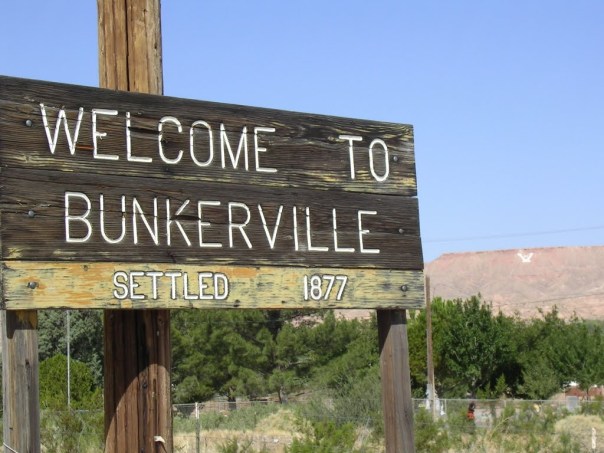
Mr. Bundy has insanely, arrogantly, or in a willful attempt at wishful thinking charged in federal court that the land was not federal land, wherein the court disagreed stating, “the public lands in Nevada are the property of the United States because the United States has held title to those public lands since 1848, when Mexico ceded the land to the United States (5). In 1999, the Ninth Circuit Court of Appeals upheld the District Court’s permanent injunction. When Mr. Bundy failed to remove his livestock as directed by the District Court, the United States filed a motion to enforce the permanent injunction and the District Court ordered Mr. Bundy to pay $1,377 as willful repeated trespass damages and adjusted fines to be consistent with regulatory rates of $45.90 per day for each day Mr. Bundy’s cattle remained on the allotment (4).
In 1999, the Las Vegas Field Office Resource Management Plan designated the Bunkerville allotment as “Closed to Grazing” to protect desert tortoise habitat.
In 2008, the BLM issued a decision to cancel Mr. Bundy’s range improvement authorizations (one range improvement permit and ten cooperative agreements). Mr. Bundy submitted a letter objecting to the action which BLM forwarded to the Interior Board of Land Appeals (IBLA) as an appeal. The IBLA issued a decision affirming the BLM’s cancellation decision on December 22, 2008. In 2011, BLM issued Mr. Bundy a Trespass Notice and Order to Cease and Desist, a Trespass Decision and Order to Remove, and a Notice of Intent to Impound. None of these communications resulted in Mr. Bundy’s voluntary removal of the trespass cattle from the public lands (4).
In May 2012, the United States filed a Complaint seeking declaratory and injunctive relief for Cliven Bundy’s trespass grazing within the Gold Butte area outside the Bunkerville Allotment, including within Lake Mead National Recreation Area. In April 2013, the United States filed a Motion to Enforce the 1998 Permanent Injunction against Cliven Bundy for the Bunkerville Allotment. On July 9, 2013, U.S. District Court of Nevada Judge Lloyd George permanently enjoined Cliven Bundy’s trespass grazing and ordered Cliven Bundy to remove his trespass cattle from public land outside the former Bunkerville Allotment within 45 days, stating that the United States is authorized to seize and impound any cattle that remain in trespass after 45 days. On October 9, 2013, U.S. District Court of Nevada Judge Larry Hicks reiterated that Cliven Bundy is permanently enjoined from grazing the Bunkerville Allotment and has no legal right to graze the federal lands, directed him to remove his trespass cattle from the former Bunkerville Allotment within 45 days, authorized the United States to impound his cattle if he fails to remove them within 45 days or continues to trespass at a future date and directed Mr. Bundy not to physically interfere with an impoundment action (4).
As can be seen, Mr. Bundy has been willfully and arrogantly breaking the law for 20 years. The BLM, the State of Nevada, and the courts have been more than civil and patient, exhausting all legal options trying to do their jobs, to enforce the law, and to resolve the problem peacefully. How Mr. Bundy has been able to ignore and bully not only state but federal agencies is beyond me. It was obviously baffling enough to the Center for Biological Diversity that in April 2012 they filed a 60 day notice of intent to sue the BLM for not doing their job under the Endangered Species Act (6). Now Cliven Bundy is playing the victim, stating that because his family has been ranching and grazing cattle there for 100 or more years, on land that is not his, he is somehow entitled to continue. His stance is not only groundless legally, it is selfish. This one man wrongly believes that his rights supersede the rights of the public and are above the law. But it’s worse than just grazing for free, Mr. Bundy has been grazing his cattle at the public’s expense.

Summer Camps & Education, Wilderness & Open Space Preservation, and Energy Development on Public Lands
We pay tax dollars to have our public lands managed, to have equal access under the law, and to have the law enforced. Mr. Bundy has made his right to graze his cattle more important than all other interests. According to Mary Jo Rugwell, who used to be the BLM Southern Nevada District Manager, “There are hundreds of ranchers that follow the rules. They have grazing permits, pay their fees and manage their cattle as they are supposed to. A lot of other users of public lands also pay for permits and follow their stipulations. It’s just not fair to all of those people that Mr. Bundy does what he wants and doesn’t follow the rules (7).” He, and others like him or supporting him, may not like the Endangered Species Act and may not like federal law or control, but not liking something does not excuse one from breaking the law. Furthermore, not believing in laws does not make them any less real, valid, or enforced. One does not change the law by breaking the law.
Mr. Bundy claims he will do whatever it takes to protect his life, liberty, and property, but none of those things would be in danger if he had actually done the one thing that would have guaranteed them: obeying the law. Clearly he was not willing to do anything. What Mr. Bundy wants is to have his cake and eat it too.
Outlaws are not victims. They are people who have chosen to go outside of the law, to claim that the law does not apply to them, and then seek support and favor from their local community when they are finally challenged and claim that they are fighting for everyone. Many famous outlaws have made such claims and gone down in myth and lore as being for the little guy or for their local communities, but history notes it differently. These were men and women who chose to break the law, not for others, but for their own selfish ends. Though we may be enamored with characters that seem to capture the essence of the wild west, we must remember that this is no longer the wild west and that they were or are outlaws, not victims. Before anyone mistakenly thinks I am comparing Mr. Bundy to those famous outlaws, I will state that the comparison ends at breaking the law. That being said, in an interview with the Moapa Valley Progress, Bundy said that he was “willing to defend his rights at all costs.” When asked whether the matter might come to violence he said, “Why not? I’ve got to protect my property. I have a right to life, liberty and property (7).” I will let you decide how similar he is to outlaws of the past.
While this is an emotional issue for many who know and like Mr. Bundy, at the end of the day, he brought this on himself. If he is a victim of anything, he is a victim of his own arrogance. He willfully broke the law and chose not to work within the confines and limits of it. He has gotten away with it for 20 years. It is time for the BLM to call his bluff and end his free grazing and law breaking now. If he wants to sue Clark County, the state of Nevada, the BLM, the cowboys who will be rounding up his cattle, or anyone else, let him do it. He does not have a case, as has been shown. His argument is weak at best, and absurd at the worst. As the court order states,
“Bundy has produced no valid law or specific facts raising a genuine issue of fact regarding federal ownership or management of public lands in Nevada, or that his cattle have not trespassed on the New Trespass Lands. The United States has established irreparable harm not only through the continuing nature of Bundy’s trespass, but because Bundy’s cattle have caused and continue to cause damage to natural and cultural resources and pose a threat to public safety. The public interest is best served by removal of trespassing cattle that cause harm to natural and cultural resources or pose a threat to the health and safety of members of the public who use the federal lands for recreation. The court finds that the public interest is negatively affected by Bundy’s continuing trespass. Finally, the public interest is served by the enforcement of Congress’ mandate for management of the public rangelands, and by having federal laws and regulations applied to all citizens equally (5).”
The BLM is not the bogeyman. It is not a nameless, faceless organization out to get one man. It is an agency filled with average, everyday people trying to do their job, and managing land for competing interests is a hard one at that. Mr. Bundy has had more than ample time to resolve this issue amicably and reasonably, it is time that he suffer the consequences that anyone else would who blatantly breaks the law. That he is seeking public support on emotional grounds here in southern Utah speaks to his lack of a case. He does not deserve our sympathy; he deserves a reality check that has been a long time coming.
Citations:
(1) Encyclopedia of The Great Plains: http://plainshumanities.unl.edu/encyclopedia/doc/egp.ag.071
(2) BLM Grazing: http://www.blm.gov/wo/st/en/prog/grazing.html
(3) BLM Mission: http://www.blm.gov/wo/st/en/prog/grazing.html
(4) BLM History of Trespass Cattle: http://www.blm.gov/nv/st/en/fo/lvfo/blm_programs/more/trespass_cattle/history_of_trepass.html
(5) Court Orders July 9th & October 9th, 2013: http://www.blm.gov/nv/st/en/fo/lvfo/blm_programs/more/trespass_cattle/court_orders.html
(6) Center for Biological Diversity, Intent to Sue: http://www.biologicaldiversity.org/species/reptiles/desert_tortoise/pdfs/60_day_notice_to_BLM_FWS__HCP_BP_IA.pdf
(7) Moapa Valley Progress, Bunkerville Rancher Holds out against Federal Officials: http://mvprogress.com/2012/04/18/bunkerville-rancher-holds-out-against-federal-officials/
(8) The Spectrum Daily News, Bundy Saddles Up: http://www.thespectrum.com/viewart/20140313/DVTONLINE01/303130030/Mesquite
(9) Las Vegas Review Journal, Emotions Run High as BLM closes 600,000 acres for cattle roundup: http://www.reviewjournal.com/news/emotions-run-high-blm-closes-600000-acres-cattle-roundup
